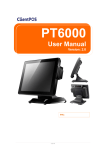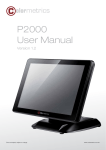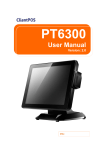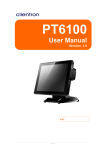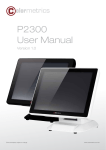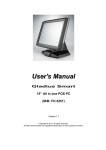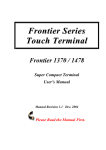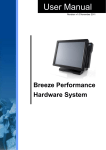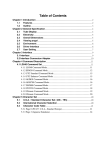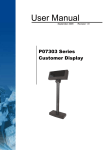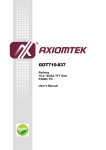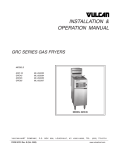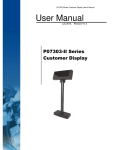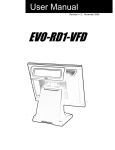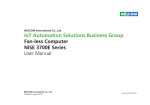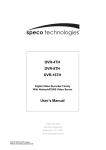Download User Manual - Amica Distribution
Transcript
PT8000 User Manual Version: 1.0 P/N : ClientPOS PT8000 User Manual Version: 1.0 Copyright Copyright 2012 Publishing. All Rights Reserved. This manual, software and firmware described in it are copyrighted by their respective owners and protected under the laws of the Universal Copyright Convention. You may not reproduce, transmit, transcribe, store in a retrieval system, or translate into any language, in any form or by any means, electronic, mechanical, magnetic, optical, chemical, biological, molecular, manual, or otherwise, any part of this publication without the express written permission of the publisher. All products and trade names described within are mentioned for identification purpose only. No affiliation with or endorsement of the manufacturer is made or implied. Product names and brands appearing in this manual are registered trademarks of their respective companies. The information published herein has been checked for accuracy as of publishing time. No representation or warranties regarding the fitness of this document for any use are made or implied by the publisher. We reserve the right to revise this document or make changes in the specifications of the product described therein at any time without notice and without obligation to notify any person of such revision or change. II ClientPOS PT8000 User Manual Version: 1.0 Safety Instructions 1. Read these instructions carefully. Keep these instructions for future reference. 2. Please disconnect this equipment from AC outlet before cleaning. Don’t use liquid or sprayed detergent for cleaning. Use moisture sheet or cloth for cleaning. 3. Please keep this equipment from humidity. 4. Lay this equipment on a reliable surface when install. A drop or fall could cause injury. 5. Make sure power cord such a way that people can not step on it. Do not place anything over the power cord. 6. All cautions and warnings on the equipment should be noted. 7. If the equipment is not used for long time, disconnect the equipment from main to avoid being damaged by transient over voltage. 8. Never pour any liquid into opening, this could cause fire or electrical shock. 9. If one of the following situations arises, get the equipment checked by a service personnel: a. The power cord or plug is damaged. b. Liquid has penetrated into the equipment. c. The equipment has been exposed to moisture. d. The equipment does not work well or you can not get it work according to user manual. e. The equipment has dropped and damaged. 10. Do not leave this equipment in an environment unconditioned, storage temperature below -20°C or above 60°C, it may damage the equipment. 11. Unplug the power cord when doing any service or adding optional kits. Lithium Battery Caution: Danger of explosion can happen if the battery is incorrectly replaced. Replace only the original or equivalent type recommended by the manufacture. Dispose used batteries according to the manufacture’s instructions. Do not remove the cover, and ensure no user serviceable components are inside. Take the unit to the service center for service and repair. III ClientPOS PT8000 User Manual Version: 1.0 CE Notice This device complies with the requirements of the CE directive. FCC Notice This equipment has been tested and found to comply with the limits for a Class B digital device, pursuant to Part 15 of the FCC rules. These limits are designed to provide reasonable protection against harmful interference in a residential installation. This equipment generates uses and can radiate radio frequency energy and, if not installed and used in accordance with the instructions, may cause harmful interference to radio communications. However, there is no guarantee that interference will not occur in a particular installation. If this equipment does cause harmful interference to radio or television reception, which can be determined by turning the equipment off and on, the user is encouraged to try to correct the interference by one or more of the following measures: Reorient or relocate the receiving antenna. Increase the separation between the equipment and receiver. Connect the equipment into an outlet on a circuit different from that to which the receiver is connected. Consult the dealer or an experienced radio/TV technician for help. Shielded interface cables must be used in order to comply with emission limits. Changes or modifications not expressly approved by the party responsible for compliance could void the user’s authority to operate the equipment. WEEE Notice This appliance is labeled in accordance with European Directive 2002/96/EC concerning waste electrical and electronic equipment (WEEE). The Directive determines the framework for the return and recycling of used appliances as applicable throughout the European Union. This label is applied to various products to indicate that the product is not to be thrown away, but rather reclaimed upon end of life per this Directive. IV ClientPOS PT8000 User Manual Version: 1.0 Table of Contents Copyright……………………………………………………. Safety Instructions………………………………………… CE /FCC/WEEE Notice…………………………………….. 1. Packing List……………………………………………… II III IV P1 1-1 Standard Accessories……………………………………….. P1 1-2 Optional Accessories………………………………………... 2. System View ……………………………...………. …… P1 P2 2-1 Rear View…………………………………………………….. P2 2-2 Specification………………………………………………….. P3 2-3 Internal Layout……………………………………………….. P4 3. Pin Definition……………………………………………... P5 4. Rear I/O Interface…………………..…………………… P9 5. System Assembly & Disassembly…………………… P11 5-1 HDD………………………………………………………….... P11 5-2 RAM…………………………………………………………... P12 5-3 CFAST………………………………………………………... P13 5-4 MSR…………………………………………………………... P13 5-5 Internal VFD………………………………………………….. P14 5-6 Wi-Fi………………………………………………………….. P15 6. Device Driver Installation……………………………… P17 6-1 Resistive Type Touch Panel …………………....………….. P17 6-2 MagStripe Card Reader Configuration Utility…………... P23 6-3 Fingerprint Reader…………………………………………. P29 6-4 RFID...………………………………………………………... P38 6-5 Internal VFD…………………………………………………. P47 6-6 i-Button Reader Configuration Utility…………………..….. P51 V ClientPOS 6-7 PT8000 User Manual Version: 1.0 Installation and Testing of Smart Card Reader…………… P54 7. BIOS/Utility Setup……………………………………….. P58 7-1 7-2 Advanced…………………………………………………….. P59 7-1-1 ACPI Configuration………………………………… P60 7-1-2 S5 RTC Wake Settings……………………………. P61 7-1-3 CPU Configuration…………………………………. P62 7-1-4 IDE Configuration…………………………………... P63 7-1-5 IT8783F Super IO Configuration…………………. P64 7-1-6 Parallel Port Configuration………………………… P66 Chipset……………………………………………………….. P67 7-2-1 Southbridge Configuration………………………… P68 7-3 Boot…………………………………………………………… P69 7-4 Security………………………………………………………. 7-5 Save & Exit…………………………………………………… P71 P70 8. LCD Surface Cleaning………………………………….. P72 VI ClientPOS 1 1-1 PT8000 User Manual Version: 1.0 Packing List Standard Accessories a. b. c. d. e. a. System (with stand) b. Power Adapter c. Power Cord d. Driver Bank e. M3 Screw x2 1-2 Optional Accessories a. b. c. 1. Single MSR 2. 3 IN 1 MSR 3. Screw x2 1| 72 ClientPOS PT8000 User Manual Version: 1.0 2 System View 2-1 Rear View 1 2 3 4 6 5 12 7 8 9 10 11 13 14 Item 1. 2. 3. 4. 5. 6. 7. 8. 9. 10. 11. 12. 13. 14. 15. 16. 17. 18. 19. 20. 21. Power Switch 19V DC-in lock connector VGA USB x4 RJ45(LAN) RJ11 for cash drawer PS/2 RJ45(COM3 for External VFD) Mic-in Line-out LPT(Option) PS/2 MSR Switch Gear(Option) COM2 COM1 MSR(Option) iButton(Option) 1D/2D Barcode Scanner(Option) RFID(Option) LCM/VFD(Option) HDD / CFast VESA Mount 15 16 17 18 19 20 ☆ Please make sure 19V DC plug in the right direction before plugging in DC jack. 21 2 | 72 ClientPOS PT8000 User Manual Version: 1.0 2 2-2 System View Specification Processor Intel Atom D2550 1.86GHZ Chipsets: North Bridge/South Bridge Intel NM10 Memory SO-DIMM socket supports DDR3 up to 4GB Audio Line-out/Mic-in Network RJ45 10/100/1000 Base-T USB 4*USB 2.0 Storage CFast card / 2.5” SATA HDD / SSD BIOS AMI UEFI BIOS Support Power DC 19V 90/65W Adaptor Thermal Solution Fan-less Dimension 37.54(W) x 37.23(H) x 26.89 (D) cm Operating Temperature 0°C ~ 40°C Storage Temperature -20°C ~ 60°C Storage Humidity -20% ~ 80%, non-condensing Display LCD Panel Size 15-inch TFT Active Matrix Display Resolution 1024*768 Pixels Backlight LED CCFL Brightness 400 cd/m2 250 cd/m2 Touch Panel 5-Wire Analog Resistive Type Note: • Intel™ Cedarview CPU does not support 64-bit OS, therefore 64-bit Microsoft Windows® Embedded POSReady 7 and 64-bit Microsoft Windows® 7 are not supported on PT8000. • Current Intel™ XP Pro / POSReady 2009 graphics driver for Cedarview platform does not support dual display. • Please avoid excessive shock during HDD operating. 3 | 72 ClientPOS PT8000 User Manual Version: 1.0 2 2-3 System View Internal Layout Front Side Backside 4 | 72 ClientPOS PT8000 User Manual Version: 1.0 3 Pin Definition 1. Power Switch (CN1) Power switch (CN1) Pin Signal 1 PWRBTN_N 2 GND 2. Internal connector fo USB6 Pin Signal 1 5V 2 D- 3 D+ 4 GND ☆ USB 6 is connected to one hub, and it is for iButton, RFID and barcode scanner. 3. VFD (COM4) Pin Signal Pin Signal 1 5V 6 CTS 2 DSR 7 TXD 3 Ground 8 RXD 4 DTR 9 Ground 5 RTS 10 12V 4. Internal connector for 3 in 1 module (USB 1) Pin Signal Pin Signal Pin Signal 1 5V 5 HUB_P1_DP 9 HUB_P3_DP 2 5V 6 HUB_P2_DN 10 GND 3 GND 7 HUB_P2_DP 11 3.3V 4 HUB_P1_DN 8 HUB_P3_DN 12 3.3V 5. PS/2 MSR (CN9) Pin Signal Pin Signal Pin Signal 1 5V 4 GND 7 K/B Clock 2 K/B Data 5 NC 8 MSR K/B Clock 3 MSR K/B Data 6 GND 5 | 72 ClientPOS PT8000 User Manual Version: 1.0 3 Pin Definition Jumper setting JP2 Pin Signal Pin Signal Pin Signal 1 K/B Data 3 MSR K/B Data 5 NC 2 K/B Clock 4 MSR K/B Clock 6 NC 6. CFast connector Pin Signal Pin Signal Pin Signal Pin Signal 1 GND 7 GND 13 NC 19 NC 2 TX 8 CDI 14 GND 20 V3.3 3 TX# 9 GND 15 NC 21 V3.3 4 GND 10 NC 16 NC 22 GND 5 RX# 11 NC 17 NC 23 GND 6 RX 12 NC 18 NC 24 CDO 7. 22Pin SATA connector Pin Signal Pin Signal Pin Signal Pin Signal 1 GND 7 GND 13 GND 19 GND 2 TX 8 V3.3 14 V5 20 V12 3 TX# 9 V3.3 15 V5 21 V12 4 GND 10 V3.3 16 V5 22 V12 5 RX# 11 GND 17 GND 6 RX 12 GND 18 ACT-/SPIN 8. RS232 type COM(For Resistive Touch) Pin Signal 1 UR 2 LR 3 SG 4 UL 5 LL 6 | 72 ClientPOS PT8000 User Manual Version: 1.0 3 Pin Definition 9. Mini PCI-E Pin Signal Pin Signal 1 Wake# 9 GND Pin Signal Pin Signal 2 +3.3V 10 RSVD 17 RSVD 35 GND 3 RSVD 11 REFCLK- 18 GND 36 USB D- 4 GND 12 RSVD 19 RSVD 37 RSVD 5 RSVD 13 REFCLK+ 20 W_Disable# 38 USB D+ 6 1.5V 14 RSVD 21 GND 39 RSVD 7 CLKREQ# 15 GND 22 PERST# 40 GND 8 RSVD 16 RSVD 23 PER_ND 41 RSVD 24 +3.3V_AUX 42 LED_WWAN# 25 PER_PD 43 RSVD 26 GND 44 LED_WLAN# 27 GND 45 RSVD 28 1.5V 46 LED_WPAN# 29 GND 47 RSVD 30 SMB_CLK 48 1.5V 31 PET_ND 49 RSVD 32 SMB_DATA 50 GND 33 PET_PD 51 RSVD 34 GND 52 3.3V Key 10. Battery Pin Signal Pin Signal 1 VRTC 2 GND 11. LPT (J7) Pin Signal Pin Signal Pin Signal 1 STB# 8 SLIN# 15 PD6 2 AFD# 9 PD3 16 GND 3 PD0 10 BUSY 17 PD7 4 ERR# 11 PD4 18 GND 5 PD1 12 PE 19 ACK# 6 INIT# 13 PD5 20 GND 7 PD2 14 SLCT 7 | 72 ClientPOS PT8000 User Manual Version: 1.0 3 Pin Definition 12. Line Out & Mic In (Audio CN8) Pin Signal Pin Signal 1 GND 6 Line_Out L 2 MIC_Th_L 7 AMP-L 3 MIC_Th_R 8 AMP-R 4 GND 9 Line_Out R 5 GND 10 GND 13. Speaker (CN5) Pin Signal 1 L+ 2 L- 3 R+ 4 R- 14. LCD Panel (LVDS) LVDS connector Back light(Inverter) Pin Signal Pin Signal Pin Signal 1 GND 11 GND 1 12V 2 GND 12 LVDS_TX1_DP 2 Ground 3 NC 13 LVDS_TX1_DN 3 No connect 4 NC 14 GND 4 Back light control 5 GND 15 LVDS_TX0_DP 5 Back light enable 6 LVDS_CLK_DP 16 LVDS_TX0_DN 7 LVDS_CLK_DN 17 GND 8 GND 18 GND 9 LVDS_TX2_DP 19 LCD_VDD 10 LVDS_TX2_DN 20 LCD_VDD 8 | 72 ClientPOS PT8000 User Manual Version: 1.0 4 Rear I/O Interface 1. COM Port Pin Signal Pin Signal Pin Signal 1 DCD 4 DTR 7 RTS 2 RXD 5 Ground 8 CTS 3 TXD 6 DSR 9 5V/12V/Ring **COM1 and COM2 Pin9 function selection by BIOS Item 2. Cash Drawer(COM 6) Pin Signal 1 Ground 2 Pin Signal 3 Open/close detection switch on drawer Drawer kick-out 4 driver signal Pin Signal 5 NC Example DOS COMMAND for Cash Drawer: 1. Create the file: TEST.TXT 2. Input below contents in TEST.TXT CONTEXT-"000.0” +12VDC for drawer kick-out supplied MODE COM6:300 6 Ground 3. Run COMMAND under DOS mode COPY TEST.TXT COM6 3. VGA Pin Signal Pin Signal Pin Signal Pin Signal 1 Red 5 GND 9 5V 13 HSYNC 2 Green 6 GND 10 GND 14 VSYNC 3 Blue 7 GND 11 NC 15 DDC_CLK 4 NC 8 GND 12 DDC_DAT 5. DC Jack 4. PS/2 Pin Signal Pin Signal Pin Signal 1 K/B Data 4 VCC 1 19V 2 Mouse Data 5 K/B Clock 2 GND 3 GND 6 Mouse Clock 3 19V 6. 2 layer USB Port Pin Signal Pin Signal 1 5V 3 D+ 2 D- 4 GND 9 | 72 ClientPOS PT8000 User Manual Version: 1.0 4 Rear I/O Interface 7. Giga LAN Pin Signal Pin Signal Pin Signal 1 VCC 6 MDI2+ L1 LED1(Green +, Orange -) 2 MDI0+ 7 MDI2- L2 LED1(Green -, Orange +) 3 MDI0- 8 MDI3+ L3 LED2(Yellow +) 4 MDI1+ 9 MDI3- L4 LED2(Yellow -) 5 MDI1- 10 GND ** LED1 : Link signal ** LED2 : Action signal 8. RJ45 type COM3 Pin Signal Pin Signal 1 5V/12V 5 RTS Pin Signal 2 DSR 6 CTS 1 5V 3 Ground 7 TXD 2 NRI#A 4 DTR 8 RXD 3 NC 4 NRI#A 5 12V 5V/12V Jumper selection (JP1) Jumper for COM3 Voltage setting JP1 JP1 ◎ ◎ ◎ ◎ ○ 1 1-2 5V 4-5 12V NOTICE: ☆ COM 3 port. Warning!! COM3 (RJ45 Connector) for external VFD use only. Never use on network device. If you are using on the network device will cause the device damaged. ☆☆ COM 3 port will be inactive if POS has internal VFD. (Alternative of COM 3 or internal VFD) 9. PS/2 MSR Switch ☆ Sliding both buttons toward the same side. Only K/B Only MSR K/B + MSR ON V X X 12 X V V V:Function X: Forbidden K/B 10 | 72 MSR ClientPOS PT8000 User Manual Version: 1.0 5 5-1 System Assembly & Disassembly HDD 1. Put the HDD on the HDD bracket HDD bracket 67D200418-000B (67D200418-000B) 2. Fasten the 4 M3 screws (64D030044-100B) 1 2 3. Unscrew 2 M3 screws (64D030060-200T) 4. Unscrew the HDD cover 5. Fabricate HDD W/bracket in HDD holder 3 6. Fasten the 2 M3 screws (64D030044-100B) 7. Fasten the 2 M3 screws 4 5 6 7 11 | 72 ClientPOS 5 5-2 PT8000 User Manual Version: 1.0 System Assembly & Disassembly RAM 1 3 2 4 1. Unscrew 2 M3 screws (64DA30104-100B) and remove MSR 2. Unscrew 4 M4 screws (64D040081-100B) and 5 remove the stand. 3. Unscrew 6 M4 screws (64D030060-200T) and remove the panel back 4. Remove the scanner cable 5. Unscrew 1 M3 screws (64D730041-100B) 6 6. Remove RAM door and install the RAM 7. Put the RAM door back. 7 12 | 72 ClientPOS 5 5-3 PT8000 User Manual Version: 1.0 System Assembly & Disassembly CFAST 1 1. Unscrew 2 M3 screws (64D030060-200T) and remove the HDD cover 2. Insert CFAST card 3. Reinstall the HDD cover 2 and secure it with screws 3 5-4 MSR 1 1. Unscrew 2 M3 screws (64D030060-200T) 2. Install MSR with screws. 2 13 | 72 ClientPOS 5 5-5 PT8000 User Manual Version: 1.0 System Assembly & Disassembly VFD 1. Remove VFD door(68D640000-000B) 2. Plug M/B side of VFD cable (35D510528-000B) into the motherboard 1 2 3 4 3. Plug the VFD cable (35D510528-000B) into the VFD device 4. Install VFD with screws. 14 | 72 ClientPOS 5 5-6 PT8000 User Manual Version: 1.0 System Assembly & Disassembly WLAN 1 1. Unscrew 2 M3 screws (64DA30104-100B) and remove MSR 2. unscrew 2 M3 screws (64D030060-200T) and 2 remove the VFD cable from the VFD module 3. Unscrew 4 M4 screws (64D040081-100B) and remove the stand. 4 3 4. Unscrew 6 M3 screws (64D030060-200T) and remove the panel back 5. Disconnect the scanner cable 6. Unscrew 8 M3 screws (64D730041-100B) 6 5 7. Unscrew 2 M3 screws (64D730041-100B) and remove the HDD with bracket 8. Unscrew 6 screws (64D730041-100B) and remove the shield cover 7 8 15 | 72 ClientPOS 5 PT8000 User Manual Version: 1.0 System Assembly & Disassembly 9. Disconnect the 2 cable 10. Adhere 2 pcs of aerials (35D510576-000B) through the red window 11. Adhere the cable clip 9 10 12. Arrange wires and adhere them on the cable clip 13. Combine the WLAN card and secure it with 1 M2 screw (64D920051-100B) 14. Connect 2 wires. 11 12 13 14 16 | 72 ClientPOS PT8000 User Manual Version: 1.0 6 6-1 Device Driver Installation Resistive Type Touch Panel 1. Click “Next”. 2. Click “Next”. 17 | 72 ClientPOS 6 PT8000 User Manual Version: 1.0 Device Driver Installation 3. Click “Next”. 4. Select “None”, Click “Next”. 5 Click “OK”. 18 | 72 ClientPOS 6 PT8000 User Manual Version: 1.0 Device Driver Installation 6. Select “Support Multi-Monitor System”, Click “Next”. 7. Click “Next”. 19 | 72 ClientPOS 6 PT8000 User Manual Version: 1.0 Device Driver Installation 8. Click “Next”. 9. Click “Next”. 20 | 72 ClientPOS 6 PT8000 User Manual Version: 1.0 Device Driver Installation 10. Select “Create a eGalaxTouch Utility shortcut on desktop”, Click “Next”. 21 | 72 ClientPOS 6 PT8000 User Manual Version: 1.0 Device Driver Installation 11. Would you do 4 point calibration now? Click “Yes”. 12. Do 4 points aligrment to match display. 13. Calibration utility. 22 | 72 ClientPOS PT8000 User Manual Version: 1.0 6 6-2 Device Driver Installation MagStripe Card Reader Configuration Utility The MagStripe Card Reader Configuration Utility is used to set up the output format of HID MSR Installation Below steps guide you how to install the Utility program Insert the setup CD Run the HID_MSR_PSW00003_V2_0_0.exe setup file that is located in the Software folder of CD. Follow the wizard to complete the installation. Launching Program Below steps guide you how to load the Utility program. From Start/Programs, click HID_MSR2 folder Click MagStripe Card Reader Configuration Utility to launch the program. 23 | 72 ClientPOS 6 PT8000 User Manual Version: 1.0 Device Driver Installation The utility program will detect the connected reader. If detected, all the input text boxes will be enabled. If the reader has not been connected to PC yet, please connect the reader and then click Refresh to get connected. Configuration Below is the main window of Utility program. For the settings, there are: Language: The language defines the code positions of the keyboard. Each language should use its own settings. Wrong language selected will cause the wrong character displayed. Prefix/Suffix: Defines the data string which you would like to append in front or end of the MSR data string. Error Message: Indicates which track number cause the error. Delimiter: Indicates the swipe result. 24 | 72 ClientPOS PT8000 User Manual Version: 1.0 6 Device Driver Installation ISO: Define start and end sentinel character. Decode Mode: Determines the way of outputting the three tracks data. Shown below is the data structure of the output string for MSR. PP PR1 SS1 PP: Prefix for package. ES2: End sentinel for track 2. PR1: Prefix for track 1. SU2: Suffix for track 2. SS1: Start sentinel for track 1. PR3: Prefix for track 3. TK1: Data for track 1, if error happens, SS3: Start sentinel for track 3. using Error Message instead. TK3: Data for track 3, if error happens, TK1 ES1 SU1 PR2 SS2 ES2 TK2 SU2 PR3 SS3 TK3 ES3 SU3 ES1: End sentinel for track 1. SU1: Suffix for track 1. ES3: End sentinel for track 3. PR2: Prefix for track 2. SU3: Suffix for track 3. SS2: Start sentinel for track 2. SU: Suffix for package. TK2: Data for track 2, if error happens, DM: Delimiter for the swipe result. using Error Message instead.. using Error Message instead. Prefix/Suffix In default, the prefix and suffix settings are all keep blank. There are 4 kinds of prefix and suffix to be defined, which are: Package: For the prefix string, it is appended in the front of the whole MSR data. For the suffix, it is appended in the end of the whole MSR data. In most case, the suffix for package is always to be the “Enter” or “Tab” character. The max data length of the prefix and suffix for the 25 | 72 SU DM ClientPOS 6 PT8000 User Manual Version: 1.0 Device Driver Installation package can be up to 127. TK1: For the prefix string, it is appended in the front of the start sentinel of track 2. For the suffix, it is appended in the end of the end sentinel of track 2. The max data length of the prefix and suffix for the TK1 can be up to 127. TK2: For the prefix string, it is appended in the front of the start sentinel of track 2. For the suffix, it is appended in the end of the end sentinel of track 2. The max data length of the prefix and suffix for the TK1 can be up to 127. TK3: For the prefix string, it is appended in the front of the start sentinel of track 3. For the suffix, it is appended in the end of the end sentinel of track 3. The max data length of the prefix and suffix for the TK1 can be up to 127. ISO This group defines the start and end sentinel for each track. The sentinel is always used to extract the track data from the whole MSR data string. The data length for each sentinel is fixed to one character. Because there is ISO standard that defining the start and end sentinel for the three tracks. For the compatible reason, please do not modify the default value if possible. Decode Mode For this group, it contains two kinds of settings, which are: Track Data Filtering: Determine which track to be, not to be output or needed to be output. Switch Output Order: Change the output order of track 1 ~ 3. 26 | 72 ClientPOS 6 PT8000 User Manual Version: 1.0 Device Driver Installation Track Data Filtering Shown below is the filter setting for track 1. This provides a fool-proofing method in case of receiving unwanted or uncompleted track data. These three filter settings are: Enable: If selected, the data of specified track will be packaged in the MSR data string. If the specified track data is not decoded, it will leave blank in the MSR data string. Required: If selected, which means the output MSR data string must contain the specified track data. If the specified track data is not decoded, even MSR data string contains other track data, it will still not to be output. Disable: If selected, the data of specified track will not be packaged in the MSR data string. No matter it is decoded or not. Switch Output Order Show below is the selection of the three track data output order (sequence). The default order is Track 1–Track 2–Track 3. 27 | 72 ClientPOS 6 PT8000 User Manual Version: 1.0 Device Driver Installation There 6 orders allow to be selected. Please select one to fit your application needs. Update Settings Once complete the settings, click Update to update the settings to connected HID MSR reader. Save Settings To save the settings to a file, click Save; specify the file name and location to be saved. Open Settings To load pre-saved settings, click Open, specify the settings file, and then click OK to load into program. Restore MSR Reader Settings To load restore settings of connected MSR reader, click Restore ES2: End sentinel for track. 28 | 72 ClientPOS PT8000 User Manual Version: 1.0 6 6-3 Device Driver Installation Fingerprint Reader 1. Check Fingerprint reader be detected by “Device manager “ 2. Select SDK folder. 3. Run Setup.exe. 29 | 72 ClientPOS 6 PT8000 User Manual Version: 1.0 Device Driver Installation 4.Click “Next”. 5. Select “ I accept the terms in the license agreement” and click “Next”. 30 | 72 ClientPOS 6 PT8000 User Manual Version: 1.0 Device Driver Installation 6. Click “Next”. 7. Click “Next”. 31 | 72 ClientPOS 6 PT8000 User Manual Version: 1.0 Device Driver Installation 8. Click “Install”. 9. Click “Finish”. 32 | 72 ClientPOS 6 PT8000 User Manual Version: 1.0 Device Driver Installation 10. Restart systems. 11. Check Fingerprint reader in Device Manager. 33 | 72 ClientPOS 6 PT8000 User Manual Version: 1.0 Device Driver Installation 12. Launch Fingerprint reader from start menu 13. Select “COM-ActiveX” 34 | 72 ClientPOS 6 PT8000 User Manual Version: 1.0 Device Driver Installation 14. Select “Sample” 15. Select ”VB6’. 35 | 72 ClientPOS 6 PT8000 User Manual Version: 1.0 Device Driver Installation 16. Select “Enrollment Sample”. 17. Enroll the fingerprint by the “Enrollment“ 18. Select “Fingerprint Enrollment” 36 | 72 ClientPOS 6 PT8000 User Manual Version: 1.0 Device Driver Installation 19. Put your finger on fingerprint reader and follow the direction to enroller your fingerprint, it need scan your fingerprint 4 times 20. After enroller finish it will popup a dialog box 37 | 72 ClientPOS PT8000 User Manual Version: 1.0 6 6-4 Device Driver Installation RFID 1. Install (Operating System: Microsoft Windows POSReady 2009) 1.1 Check the Device Manager to verify the status of RFID reader. Computer Management -> Device Manager -> Other devices (The device will show a question mark if the installation is not done properly.) 1.2 Install RFID driver,file name:XP2KxVista.exe 2-1 Path:\USB Driver\ XP2KxVista.exe 38 | 72 ClientPOS 6 PT8000 User Manual Version: 1.0 Device Driver Installation 1.2.1 After clicking Next, A pop up console window appears as below. 1.2.2 Check the Device Manager to verify the status of RFID reader. Computer Management -> Device Manager -> Ports (COM & LPT) 39 | 72 ClientPOS 6 PT8000 User Manual Version: 1.0 Device Driver Installation 1.3 install RFID utility MifareDemoSetup_PSW00020.exe 3-1 Path:\MF320\MifareDemoSetup_PSW00020.exe 1.3.1 InstallShield Wizard will be activated. 40 | 72 ClientPOS 6 PT8000 User Manual Version: 1.0 Device Driver Installation 1.3.2 Click “Next”. 1.3.3 Click “Next”. 41 | 72 ClientPOS 6 PT8000 User Manual Version: 1.0 Device Driver Installation 1.3.4 Click “Giga-TMS” & “Next”. 1.3.5 Click “Next”. 42 | 72 ClientPOS 6 PT8000 User Manual Version: 1.0 Device Driver Installation 1.3.6 Click “Finish” 2. Run RFID demo program. Start -> All Programs -> GIGA-TMS -> Mifare Demo 43 | 72 ClientPOS 6 PT8000 User Manual Version: 1.0 Device Driver Installation 2.1 Run “Auto Scan” Demo AP will detect the RFID reader automatically. Or select the RFID COM port 2.2 After finishing the AutoScan, Request box will be ready for the click and Reader Version will show on the position as marked. (Reader Version: PGM-T1235 V1.0R3 (101230) Place Mifare Card to the RFID reader area. Event Dialog window gets the data from the Mifare Card. 44 | 72 ClientPOS 6 PT8000 User Manual Version: 1.0 Device Driver Installation Place the RFID card on the RFID reader. 2.3 Card type will be recognized when you click “Request”. (Your Mifare card should be placed on the RFID reader area.) 2.4 Card ID will be recognized when you click “Card ID”. 45 | 72 ClientPOS 6 PT8000 User Manual Version: 1.0 Device Driver Installation 2.5 SAK will be read when you click “Select”. 2.6 The result will show when you click “Authenticate”. 46 | 72 ClientPOS PT8000 User Manual Version: 1.0 6 6-5 Device Driver Installation Internal VFD Specification Display Method Vacuum Fluorescent Display(blue-Green) Number of Characters 40 (20 Columns X 2 Lines) Brightness 500 ~ 1000 cd/m2 Character Font 5X7 Doc Matrix Character Type 95 Alphanumeric, 32 International Characters Character Size 6.75(H) X 3.75(W)mm Doc Size (X x Y) 0.55 x 0.75 mm Download Characters 9 Characters General Commands Mode Language Support LD220, EPSON POS D101(default), AEDEX, UTC/S, UTC/P, ADM788, DSP800, CD5220, EMAX, LOGIC CONTROL USA, France, Germany, UK, Sweden, Denmark I & II, Italy, Spain, Norway, Japan(Katakana), Slavonic, Russian, Greek, Czech, Lativain Interface RS-232(Serial) Connection Baud Rate Direct Connection 9600 or 19,200 bps Reliability MTBF 30,000 Hours Power Consumption 5-12 VDC Safety EMC Standards & Safety Standards FCC, CE 47 | 72 ClientPOS 6 PT8000 User Manual Version: 1.0 Device Driver Installation 48 | 72 ClientPOS 6 PT8000 User Manual Version: 1.0 Device Driver Installation 49 | 72 ClientPOS 6 PT8000 User Manual Version: 1.0 Device Driver Installation 50 | 72 ClientPOS PT8000 User Manual Version: 1.0 6 6-6 Device Driver Installation i-Button Reader Configuration Utility The i-Button Reader Configuration Utility is used to set up the output format of HID MSR Installation Below steps guide you how to install the Utility program. Insert the setup CD Run the HID_MSR_PSW00003_V2_0_0.exe setup file that is located in the Software folder of CD. Follow the wizard to complete the installation. Launching Program Below steps guide you how to load the Utility program. From Start/Programs, click HID_MSR2 folder Click MagStripe Card Reader Configuration Utility to launch the program. 51 | 72 ClientPOS 6 PT8000 User Manual Version: 1.0 Device Driver Installation The utility program will detect the connected reader. If detected, all the input text boxes will be enabled. If the reader has not been connected to PC yet, please connect the reader and then click Refresh to get connected. Configuration Below is the main window of i-Button Utility program. For the settings, there are: Prefix/Suffix: Defines the data string which you would like to append in front or end of the i-Button key string. Error Message: Indicates error message when i-Button key read fail. Message: Indicates message when i-Button key read correctly SS/ES : Define Start and End sentinel byte for the i-Button ID string Length : i-Button ID length request from 0~16 Output order : 4 format could be select at Attach /Remove i-Button ID 52 | 72 ClientPOS 6 PT8000 User Manual Version: 1.0 Device Driver Installation Update Settings Once complete the settings, click Update to update the settings to connected HID MSR reader. Save Settings To save the settings to a file, click Save; specify the file name and location to be saved. Open Settings To load pre-saved settings, click Open, specify the settings file, and then click OK to load into program. Restore iButton Reader Settings To load restore settings of connected iButton reader, click Restore ES2: End sentinel for track. 53 | 72 ClientPOS 6 6-7 1. PT8000 User Manual Version: 1.0 Device Driver Installation Installation and Testing of Smart Card Reader Check smart card reader be detected by “Device manager”. 2. Install the SCR driver. 54 | 72 ClientPOS 6 PT8000 User Manual Version: 1.0 Device Driver Installation 3. Run Setup.exe. 4. Click “Yes”. 5. Restart systems. 55 | 72 ClientPOS 6 PT8000 User Manual Version: 1.0 Device Driver Installation 6. Check SCR reader in Device Manager. 7. Run the testing program – EZ100test. 56 | 72 ClientPOS 6 PT8000 User Manual Version: 1.0 Device Driver Installation 8. Conferm that SCR can be detected by the testing program, then run the program - the Start Testing. 9. Follow dialog boxes displayed to remove and insert card. 10. After finishing the testing, the dialog box will show “oK”. 57 | 72 ClientPOS 7 PT8000 User Manual Version: 1.0 BIOS/Utility setup Press <DEL > / <F2> key to enter BIOS SETUP UTILITY when system boot up. ☆ Please press <DEL > / <F2> key tenderly and slowly. Date and Time The Date and Time items show the current date and time on the computer. If you are running a Windows OS, these items are automatically updated whenever you make changes to the Windows Date and Time Properties utility. WARNING! Setting the wrong values in the sections below may cause the system to malfunction. Make sure that the settings made are compatible with the hardware. 58 | 72 ClientPOS PT8000 User Manual Version: 1.0 7 7-1 BIOS/Utility setup Advanced Use the Advanced menu to configure the CPU and peripheral devices through the following sub-menus: Launch PXE OPROM: Enable or Disable PXE Function 59 | 72 ClientPOS PT8000 User Manual Version: 1.0 7 7-1-1 BIOS/Utility setup ACPI Configuration The ACPI Configuration menu configures the Advanced Configuration and Power Interface (ACPI) options ACPI Sleep State Use the ACPI Sleep State option to specify the sleep state the system enters when it is not being used. 1. Suspend Disabled 2. S1 (CPU Stop Clock) DEFAULT The system enters S1 (POS) sleep state. The system appears off. The CPU is stopped; RAM is refreshed; the system is running in a low power mode. 3. S3 (Suspend to RAM) The caches are flushed and the CPU is powered off. Power to the RAM is maintained. The computer returns slower to a working state, but more power is saved. 60 | 72 ClientPOS 7 PT8000 User Manual Version: 1.0 BIOS/Utility setup 7-1-2 S5 RTC Wake Settings Enable or disable system wake on alarm event. When enabled, system will wake on the hr::min::sec specified. 61 | 72 ClientPOS 7 PT8000 User Manual Version: 1.0 BIOS/Utility setup 7-1-3 CPU Configuration Use the CPU Configuration menu to enter the CPU Information submenu or setup Intel CPU parameter. 62 | 72 ClientPOS PT8000 User Manual Version: 1.0 7 BIOS/Utility setup 7-1-4 IDE Configuration Use the SATA Configuration menu to change and/or set the configuration of the SATA devices installed in the system. SATA Mode Use the SATA Mode option to configure SATA devices as normal IDE devices. Disable Disables SATA devices. IDE Mode Configures SATA devices as normal IDE device. RAID Mode Configures SATA devices as RAID device. 63 | 72 ClientPOS 7 7-1-5 PT8000 User Manual Version: 1.0 BIOS/Utility setup IT8783F Super IO Configuration Use the Super IO Configuration menu to set or change the configurations for parallel ports and serial ports. 64 | 72 ClientPOS PT8000 User Manual Version: 1.0 7 BIOS/Utility setup Serial Port n Configuration Use the Serial Port n Configuration menu to configure the serial port n. Serial Port [Enabled] Use the Serial Port option to enable or disable the serial port. Disabled Disable the serial port Enabled Enable the serial port Change Settings [Auto] Use the Change Settings option to change the serial port IO port address and interrupt address. Auto The serial port IO port address and interrupt address are automatically detected. Serial Port 1/2 Voltage Select [STD] Select "COM1/2 PIN9 Function" and press <Enter> to setup COM 1/2 PIN9 function. ITEM COM1 PIN9 Function COM2 PIN9 Function Option STD (Default) 5V Descriptions COM1/2 Pin9 select RING function COM1/2 Pin9 select 5V/12V function 12V 65 | 72 ClientPOS 7 PT8000 User Manual Version: 1.0 BIOS/Utility setup 7-1-6 Parallel Port Configuration Use the Parallel Port Configuration menu to configure the parallel port. 66 | 72 ClientPOS PT8000 User Manual Version: 1.0 7 7-2 BIOS/Utility setup Chipset Use the Chipset menu to access the Southbridge configuration menus WARNING! Setting the wrong values for the Chipset BIOS selections in the Chipset BIOS menu may cause the system to malfunction. 67 | 72 ClientPOS 7 PT8000 User Manual Version: 1.0 BIOS/Utility setup 7-2-1 Southbridge Configuration Use the Southbridge Configuration menu to configure the Southbridge chipset. 68 | 72 ClientPOS PT8000 User Manual Version: 1.0 7 7-3 BIOS/Utility setup Boot Use the Boot menu to configure system boot options. Bootup NumLock State [On] Use the Bootup NumLock State BIOS option to specify if the number lock setting must be modified during boot up. Quiet Boot [Enabled] Use the Quiet Boot BIOS option to select the screen display when the system boots. 69 | 72 ClientPOS PT8000 User Manual Version: 1.0 7 7-4 BIOS/Utility setup Security Use the Security menu to set system and user passwords. Administrator Password Use the Administrator Password to set or change an administrator password. User Password Use the User Password to set or change a user password. 70 | 72 ClientPOS PT8000 User Manual Version: 1.0 7 7-5 BIOS/Utility setup Save & Exit Use the Save & Exit menu to load default BIOS values, optimal failsafe values and to save configuration changes. 71 | 72 ClientPOS PT8000 User Manual Version: 1.0 8 LCD Surface Cleaning 1. How to clean the LCD surface properly? ☆ Do not spray any liquids on the LCD screen directly, and do not use paper towels, this can cause the LCD screen to become scratched. ☆ Always apply the solution to your cloth first, not directly to the parts you are cleaning. You want to avoid dripping the solution directly into your computer or laptop. ☆ Stroke the cloth across the display in one direction, moving from the top of the display to the bottom. 2. What are some of the basic supplies needed to clean an LCD screen? ☆ A soft cotton cloth. When cleaning the LCD screen it is important to use a soft cotton cloth, rather than an old rag. Some materials, such as paper towels, could cause scratches and damage the LCD screen. ☆ Solution of water and isopropyl alcohol. This solution can be used along with the soft cotton cloth. ☆ Computer wipes. Only use these if they specifically state on the package they are designed for LCD laptop screens. Computer wipes can come in handy for fast clean-ups or when you want to avoid mixing up a cleaning solution yourself. 3. What types of cleaners are acceptable? ☆ Water ☆ Vinegar (mixed with water) ☆ Isopropyl Alcohol NOTICE: The following cleaners are unacceptable: ☆ Acetone ☆ Ethyl alcohol ☆ Ethyl acid ☆ Ammonia ☆ Methyl chloride 72| 72














































































